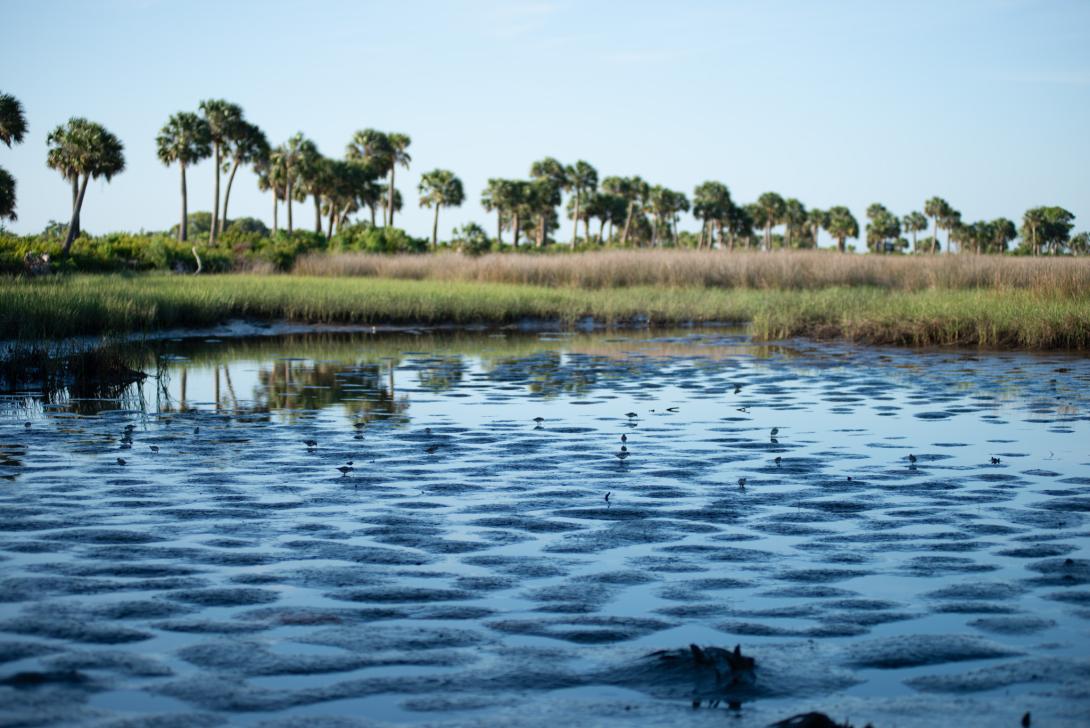Big Bend Seagrasses Aquatic Preserve
NEWS | RESOURCES | CALENDAR
Big Bend Seagrasses Aquatic Preserve is located on Florida's Gulf Coast and spans over 150 miles of coastline, extending from Apalachee Bay southward to the Withlacoochee River. The main communities located along the coastline of the aquatic preserve include Keaton Beach, Steinhatchee, Horseshoe Beach, Suwannee and Cedar Key.
Wakulla, Jefferson, Taylor, Dixie, Levy
1985
984,325
Gulf of America, estuaries, rivers
Open 24/7 dependent on public access points, which are managed by other entities.
Swimming, wildlife viewing, boating, canoeing and kayaking, scalloping, fishing
VISITATION INFORMATION
Visiting the Big Bend Seagrasses Aquatic Preserve offers abundant recreational opportunities due to its vast and minimally developed coastline, which supports activities such as swimming, wildlife viewing, boating, canoeing, kayaking, scalloping and fishing. The region has several boat ramps that facilitate access to this aquatic preserve. Additionally, visitors can explore the Big Bend Saltwater Paddling Trail. Big Bend Seagrasses Aquatic Preserve is also surrounded by various state parks and national wildlife refuges.
Parking
Parking availability varies according to specific access points. Visitors are reminded not to leave valuables in vehicles parked at remote access points.
Boat Access/Ramps
- St. Marks
- Econfina River State Park
- Keaton Beach
- Dark Island
- Steinhatchee
- Horseshoe Beach
- Suwannee River
- Cedar Key
- Withlacoochee River
- Waccasassa Bay Preserve State Park
Contact
Sandra Chupinsky
352-228-6035
Sandra.Chupinsky@FloridaDEP.gov
HISTORY
The Big Bend Seagrasses Aquatic Preserve is the largest aquatic preserve in Florida. Established in 1985, the aquatic preserve spans approximately 984,325 acres. This coastal region is unique for its extensive open waters allowing various rivers, creeks and marshes to flow directly into the Gulf of America. This aquatic preserve's karst geology, marked by porous limestone, creates features like springs, sinks, caverns and underground corridors, with extensive seagrass beds and salt marshes that serve as essential habitats for numerous marine species.

PUBLIC ENGAGEMENT OPPORTUNITIES
Volunteer Opportunities
Marine debris cleanups
Events
International Coastal Cleanup each September in Cedar Key
Conservation Efforts
- Water Quality Monitoring: The preserve staff monitors water quality throughout the region through monthly nutrient sampling and long-term, continuous water quality monitoring. As part of their efforts, they collect water samples each month across the region for nutrient analysis. Additionally, in Steinhatchee, they use YSI EXO 2 Sondes to continuously monitor water quality, gathering data on temperature, salinity/conductivity, pH, dissolved oxygen, depth, turbidity and chlorophyll. Together, these efforts provide valuable insights into the overall health of the ecosystem.
- Seagrass Monitoring: The preserve staff monitors seagrass and macroalgae at 100 fixed locations each summer, tracking changes in species, coverage and overall health.
A full list of data and reports can be found on SEACAR.
- Boater Education: The "Scars Hurt: Be Seagrass Safe" campaign educates boaters about safe boating practices in shallow seagrass areas to prevent damage from propellers.
- Marine Debris Cleanup: Preserve staff participate in multiple marine debris removal events each year. Removing marine debris like derelict crab traps, which can shade out seagrass, allows for submerged aquatic vegetation such as seagrass and algae to recover.
Ongoing Research
- The University of Florida: conducts many projects in Big Bend Seagrasses Aquatic Preserve, out of the NCBS including shellfish aquaculture, living shorelines, fisheries, project TRAP and more.
- Florida State University: has long term shark monitoring.
- Fish and Wildlife Research Institute: uses project SIMMS.
- Suwannee River Water Management District: conducts water quality monitoring.
- In Water Research Group: conducts sea turtle surveys.
Partner Groups
- University of Florida
- University of Florida's Insitute of Agricultural Sciences (UF/IFAS)
- Florida Sea Grant
Big Bend Seagrasses Aquatic Preserve (BBSAP) partners with Florida Public Archeological Network (FPAN) on outreach events, most recently participated in Moon Over the Mounds at the Crystal River Archeological State Park, learning about the cultural and historical importance of the area.
With a short week due to the holiday, Big Bend Seagrasses Aquatic Preserve was able to get in a day of fieldwork by heading out to Keaton Beach to monitor the seagrass where the 2023 urchin mass grazing event took place. In February 2023, an urchin bloom was reported off the coast of Keaton Beach. Staff began monitoring the urchin front and the seagrass response with monthly surveys.
Big Bend kicked off its first day of seagrass surveys last week in Steinhatchee. With heavy rain threatening to brown out many of the sites, the team launched two boats and set out to sample the entire system in one day. Thanks to the help of Nature Coast Aquatic Preserve contractor Morgan Edwards, all 25 sites were completed. It was no easy task, as each site required four replicate quadrats, but the team got it done.